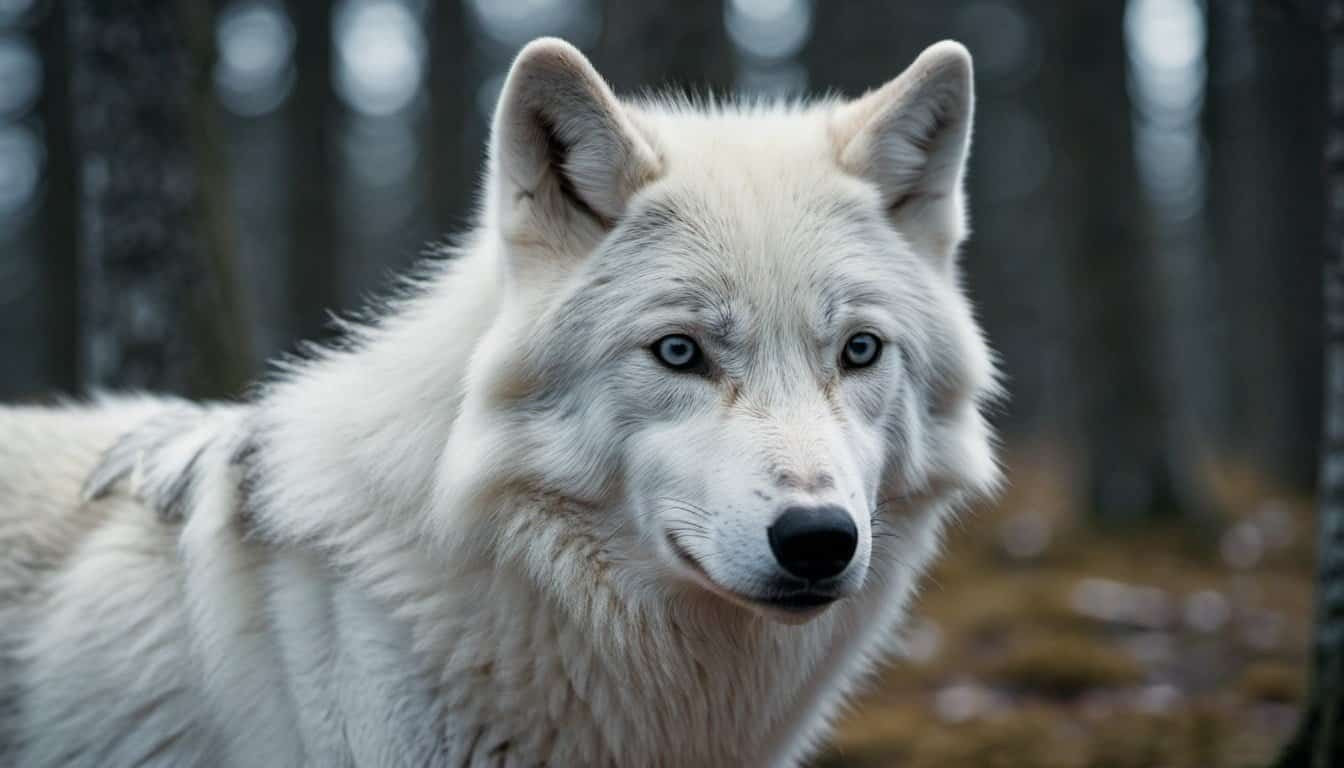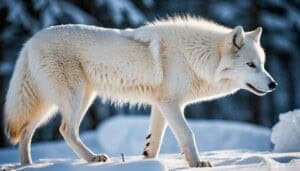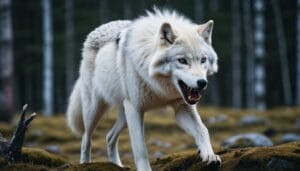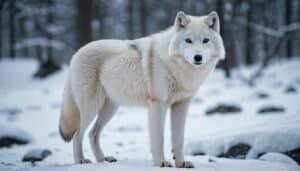Introduction
The Arctic wolf, a fascinating creature adapted to the harsh conditions of the Arctic, relies heavily on the efficient functioning of its liver
This vital organ plays several key roles, including digestion, detoxification, and metabolism, and is essential for the wolf’s survival in its frigid habitat
Throughout this article, we will explore the various functions of the Arctic wolf’s liver, its unique features, health concerns, and the impact of its diet on liver performance
The Functions of the Arctic Wolf’s Liver
The Arctic wolf’s liver is a multifunctional organ that plays a crucial role in maintaining the animal’s health and supporting its survival in the harsh Arctic environment
It is responsible for several vital processes, including digestion, detoxification, metabolism, and adaptation to cold environments
Digestion
The liver is integral to the Arctic wolf’s digestive system. It produces bile, a substance that aids in the digestion and absorption of fats. Bile is stored in the gallbladder and released into the small intestine during digestion
The emulsification of fats by bile allows enzymes to break down fat molecules into fatty acids and glycerol, which can then be absorbed by the intestinal lining and utilized by the body for energy and other functions
Detoxification
Detoxification is another critical function of the Arctic wolf’s liver. This organ filters and removes toxins from the blood, converting them into less harmful substances that can be excreted from the body
The liver detoxifies various compounds, including metabolic waste products, ingested toxins, and drugs. By performing this function, the liver helps protect the Arctic wolf from harmful substances that could otherwise compromise its health
Metabolism
The liver also plays a pivotal role in the Arctic wolf’s metabolism. It regulates the metabolism of carbohydrates, fats, and proteins, ensuring that the wolf has a steady supply of energy and nutrients. The liver converts excess glucose into glycogen for storage, which can be converted back into glucose when needed
It also processes amino acids, synthesizes proteins, and converts excess carbohydrates and proteins into fats for long-term energy storage. These metabolic processes are essential for maintaining the Arctic wolf’s energy balance and overall health
Adaptation to Cold Environment
The Arctic wolf’s liver has adapted to the cold environment in which it lives. The liver’s efficient metabolic processes help maintain the wolf’s body temperature and energy levels, even in extremely low temperatures
The liver’s ability to store and mobilize energy reserves is particularly important for the Arctic wolf, which often faces periods of food scarcity during the harsh winter months. The liver’s role in producing heat through metabolic processes also contributes to the wolf’s ability to endure the cold
Unique Features and Health of the Arctic Wolf’s Liver
The Arctic wolf’s liver exhibits several unique features and is subject to health concerns that can impact its overall well-being. Understanding these aspects helps in appreciating how this organ supports the Arctic wolf’s survival in its extreme environment
Comparison to Other Wolves
The Arctic wolf’s liver shares many similarities with the livers of other wolf species, but there are distinct differences that have evolved due to the Arctic wolf’s unique habitat. The liver size and metabolic rate can vary, with the Arctic wolf’s liver potentially being more efficient in energy storage and utilization
This efficiency is crucial for surviving long periods of food scarcity common in the Arctic regions. Additionally, the liver’s ability to process high-fat diets, primarily from marine and terrestrial prey, is more pronounced in Arctic wolves compared to their temperate counterparts
Structural Characteristics
Structurally, the Arctic wolf’s liver is adapted to withstand the stresses of the harsh Arctic environment. The hepatic cells, or hepatocytes, in the Arctic wolf’s liver may exhibit enhanced functionality in processing fats and detoxifying the body, reflecting the wolf’s dietary habits and exposure to environmental toxins
The liver is divided into lobes, with a robust blood supply that ensures efficient nutrient and oxygen delivery, crucial for maintaining the wolf’s health in extreme conditions. The liver’s regenerative capability is also notable, allowing it to recover from injuries and sustain its functions over the wolf’s lifespan
Common Diseases
The Arctic wolf’s liver, like that of other animals, can be susceptible to various diseases. Hepatitis, fatty liver disease, and liver fibrosis are conditions that may affect the Arctic wolf, often exacerbated by poor diet, toxins, or infections
Parasitic infections, such as those caused by tapeworms or flukes, can also impact liver health. Early detection and treatment are challenging in the wild, making these diseases a significant threat to the Arctic wolf population
Understanding these diseases is crucial for conservation efforts and ensuring the health of Arctic wolves in the wild
Immune System Support
The liver plays a critical role in supporting the Arctic wolf’s immune system. It produces proteins involved in immune responses, such as complement proteins, which help fight off infections. The liver also filters bacteria and pathogens from the blood, reducing the risk of systemic infections
This immunological function is vital for the Arctic wolf, which often encounters harsh and challenging conditions that can compromise its health. The liver’s ability to support the immune system enhances the wolf’s resilience to diseases and infections prevalent in the Arctic environment
Influence of Diet on Liver Function
The Arctic wolf’s diet significantly influences the functioning and health of its liver. Given the unique dietary habits of these wolves, their liver must adapt to process and derive nutrients from their prey effectively
Dietary Needs
Arctic wolves primarily feed on a carnivorous diet, which includes a variety of prey such as muskoxen, Arctic hares, seals, and lemmings. The high-protein and high-fat content of their diet requires their liver to be adept at processing large amounts of animal fats and proteins. This organ converts the nutrients obtained from their prey into energy and other necessary compounds
During periods of scarcity, the liver’s ability to store glycogen and convert fats into energy becomes essential for survival. The Arctic wolf’s liver must also manage the metabolism of these nutrients to ensure the wolf remains energetic and healthy
Impact of Prey on Liver Health
The type and quality of prey consumed by the Arctic wolf can directly impact the health of its liver. For instance, consuming prey that is rich in healthy fats, such as seals, can provide beneficial nutrients that support liver function
However, the liver must also handle any toxins or parasites present in their prey. Ingesting contaminated or unhealthy prey can lead to liver diseases or compromise liver function
Additionally, the liver must detoxify any harmful substances the wolf may encounter in its environment, such as pollutants or toxins present in their prey. This constant detoxification process is crucial to prevent liver damage and maintain overall health
The seasonal availability of prey also plays a role in liver health. During the harsh winter months, when prey is scarce, the liver’s ability to mobilize stored nutrients becomes vital. Prolonged periods of fasting can strain the liver, but the Arctic wolf’s liver is adapted to efficiently manage these periods of scarcity by breaking down stored glycogen and fats to provide energy
Conclusion
The Arctic wolf’s liver is an extraordinary organ, essential for the wolf’s survival in the harsh Arctic environment. Its functions encompass critical processes such as digestion, detoxification, metabolism, and adaptation to cold climates
The liver’s efficiency in breaking down fats and proteins, detoxifying harmful substances, and storing and mobilizing energy reserves ensures that the Arctic wolf can thrive even during periods of food scarcity
Unique structural characteristics and metabolic adaptations distinguish the Arctic wolf’s liver from those of other wolves, reflecting its specialized dietary and environmental needs
However, like all animals, the Arctic wolf is susceptible to liver diseases, which can be exacerbated by poor diet, infections, and environmental toxins. Understanding these health concerns is vital for conservation efforts
The diet of the Arctic wolf has a profound impact on liver function. Consuming high-fat and high-protein prey necessitates a liver capable of efficient nutrient processing and detoxification. Seasonal variations in prey availability further test the liver’s adaptability and resilience
Overall, the Arctic wolf’s liver exemplifies the intricate balance of physiological functions required for survival in one of the planet’s most extreme environments. Through ongoing research and conservation, we can continue to understand and protect these magnificent creatures and their critical organ systems










